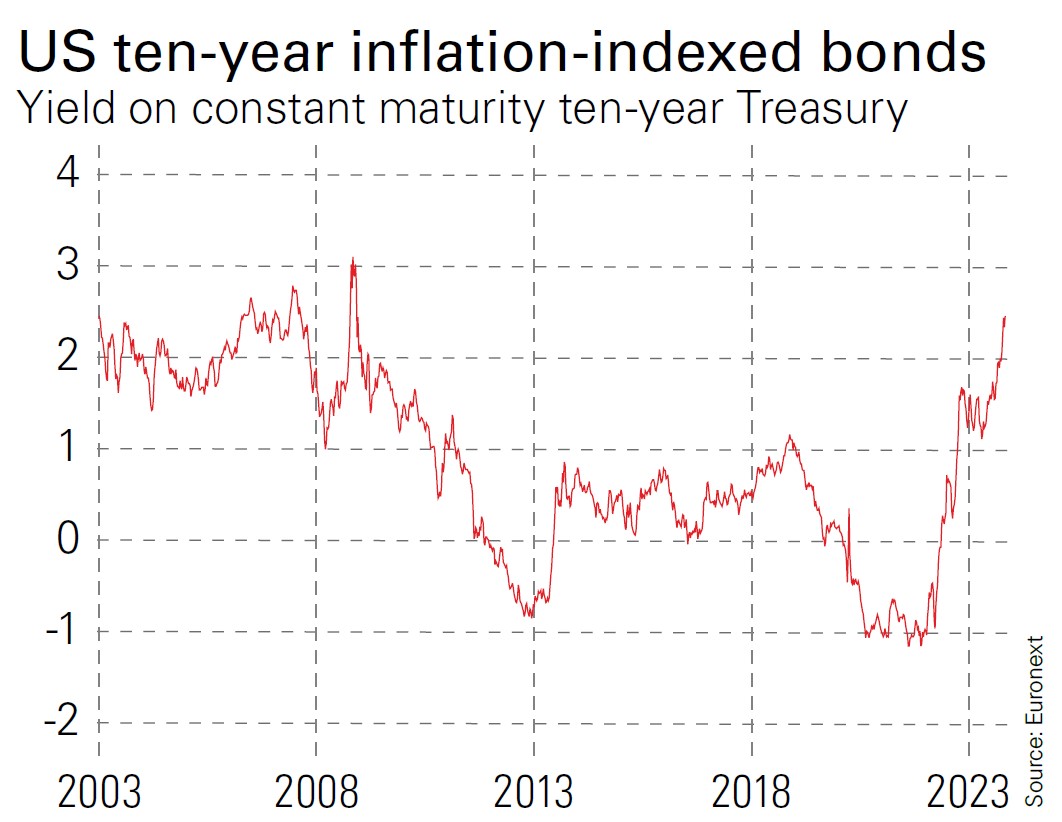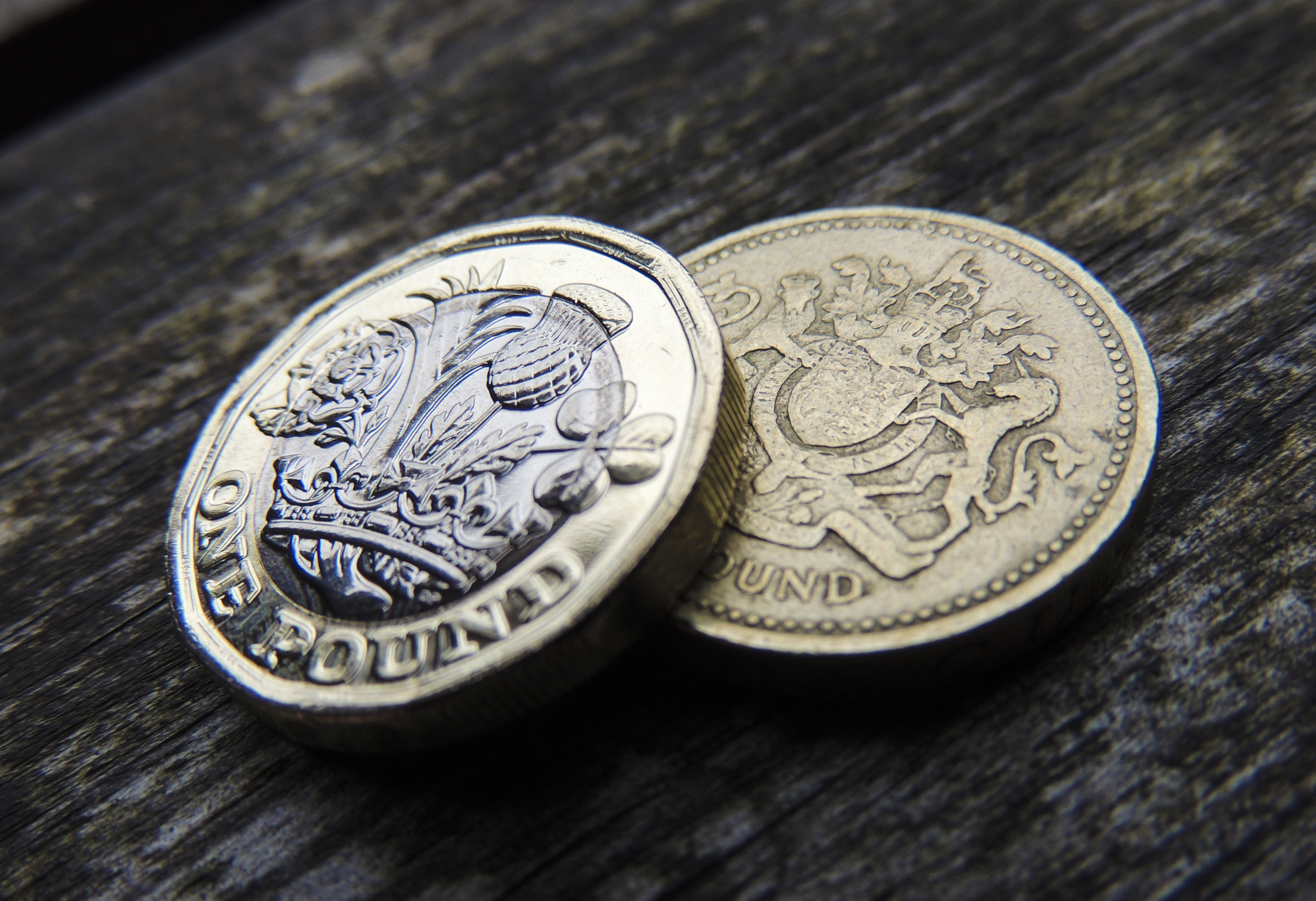Inflation-linked bonds – lock in a real yield
Inflation-linked bonds look more compelling than they have done for many years, especially in the US


I recently said that even though conventional bond yields have risen a long way from their lows, we’re not yet tempted by them for our asset-allocation portfolio, except perhaps very short-dated bonds.
We’re not forecasting that rates are going much higher in the short term (we forecast as little as possible), but it seems clear that yields don’t offer much compensation for the risk that they do. They seem pretty much at the lower end of where you’d expect them to be.
Inflation-linked bonds are rather different. At present, ten-year US Treasury inflation-protected securities (TIPS) pay a real yield of about 2.5%, which is almost as high as they’ve been for 20 years (see chart).
MoneyWeek
Subscribe to MoneyWeek today and get your first six magazine issues absolutely FREE

Sign up to Money Morning
Don't miss the latest investment and personal finances news, market analysis, plus money-saving tips with our free twice-daily newsletter
Don't miss the latest investment and personal finances news, market analysis, plus money-saving tips with our free twice-daily newsletter

When they were first issued in the late 1990s, enthusiasm was surprisingly low and real yields were higher – above 4% at times – but it would be optimistic to expect that again. Perhaps investors would again demand higher yields in a very high-inflation world (to compensate for greater uncertainty and the risk of the government fiddling the inflation figures), but on the face of it, Tips yields are not terrible by historical standards.
Meanwhile, the ten-year break-even inflation rate (the implicit forecast for inflation calculated from the difference between yields on Tips and on conventional bonds) is also now roughly 2.5% (since the yield on conventional ten-year bonds is currently about 5%).
When break-evens are high relative to probable inflation, it could be a good time to buy conventional bonds; when they are low, it could be a good time to buy linkers. Actual US inflation over the past 20 years has, in fact, been around 2.5% per year, so markets are implying more of the same.
We have no way of knowing whether that will be right, but note that conventional ten-year bonds have returned 1.7% per year after inflation over the past 25 years and 2.6% per year over 50 years. There were periods of higher returns in the 1980s, 1990s and 2000s, but that was with the tailwinds of higher nominal rates and falling inflation. In today’s world, locking a 2.5% real yield via Tips looks at least reasonable value.
The problem with gilts
As a British investor, why am I focusing on Tips and not UK index-linked gilts here?
In short, because the UK linker market is messy. First, UK linkers are indexed to the old retail price index (RPI), not the consumer price index (CPI) – but most investors use CPI as a benchmark, so market prices have to reflect expectations for the likely difference between RPI and CPI.
Second, the link will switch – without compensation – from RPI to CPI, including housing (CPIH), in 2030 creating further complications in valuing them. Third, the prices are distorted by the huge appetite that pension funds have for linkers. At present, real yields on ten-year UK linkers are around 1%. The difference between RPI and CPI is unstable but averages about 1%. So likely returns seem worse and complications abound. Thus we favour Tips in the portfolio.
However, I’ll look at the choice of exchange-traded funds for both US and UK linkers in my next column.
This article was first published in MoneyWeek's magazine. Enjoy exclusive early access to news, opinion and analysis from our team of financial experts with a MoneyWeek subscription.
Get the latest financial news, insights and expert analysis from our award-winning MoneyWeek team, to help you understand what really matters when it comes to your finances.
Cris Sholto Heaton is an investment analyst and writer who has been contributing to MoneyWeek since 2006 and was managing editor of the magazine between 2016 and 2018. He is especially interested in international investing, believing many investors still focus too much on their home markets and that it pays to take advantage of all the opportunities the world offers. He often writes about Asian equities, international income and global asset allocation.
Cris began his career in financial services consultancy at PwC and Lane Clark & Peacock, before an abrupt change of direction into oil, gas and energy at Petroleum Economist and Platts and subsequently into investment research and writing. In addition to his articles for MoneyWeek, he also works with a number of asset managers, consultancies and financial information providers.
He holds the Chartered Financial Analyst designation and the Investment Management Certificate, as well as degrees in finance and mathematics. He has also studied acting, film-making and photography, and strongly suspects that an awareness of what makes a compelling story is just as important for understanding markets as any amount of qualifications.
-
 What to do with old £1 coins
What to do with old £1 coinsThe old one pound coin was demonetised in 2017, but there are still millions out there in the UK. Here’s what to do if you find an old £1.
-
 December Premium Bonds winners announced – did you win £1 million?
December Premium Bonds winners announced – did you win £1 million?Over 2.6 million historic Premium Bonds prizes are still waiting to be claimed, according to NS&I
-
 Big Short investor Michael Burry closes hedge fund Scion Capital
Big Short investor Michael Burry closes hedge fund Scion CapitalProfile Michael Burry rightly bet against the US mortgage market before the 2008 crisis. Now he is worried about the AI boom
-
 The global defence boom has moved beyond Europe – here’s how to profit
The global defence boom has moved beyond Europe – here’s how to profitOpinion Tom Bailey, head of research for the Future of Defence Indo-Pac ex-China UCITS ETF, picks three defence stocks where he'd put his money
-
 Profit from a return to the office with Workspace
Profit from a return to the office with WorkspaceWorkspace is an unloved play on the real estate investment trust sector as demand for flexible office space rises
-
 New frontiers: the future of cybersecurity and how to invest
New frontiers: the future of cybersecurity and how to investMatthew Partridge reviews the key trends in the cybersecurity sector and how to profit
-
 An “existential crisis” for investment trusts? We’ve heard it all before in the 70s
An “existential crisis” for investment trusts? We’ve heard it all before in the 70sOpinion Those fearing for the future of investment trusts should remember what happened 50 years ago, says Max King
-
 8 of the best properties for sale with wildlife ponds
8 of the best properties for sale with wildlife pondsThe best properties for sale with wildlife ponds – from a 16th-century house in the Ashdown Forest, to a property on Pembrokeshire’s Preseli Hills
-
 Why a copper crunch is looming
Why a copper crunch is loomingMiners are not investing in new copper supply despite rising demand from electrification of the economy, says Cris Sholto Heaton
-
 Where to look for Christmas gifts for collectors
Where to look for Christmas gifts for collectors“Buy now” marketplaces are rich hunting grounds when it comes to buying Christmas gifts for collectors, says Chris Carter
